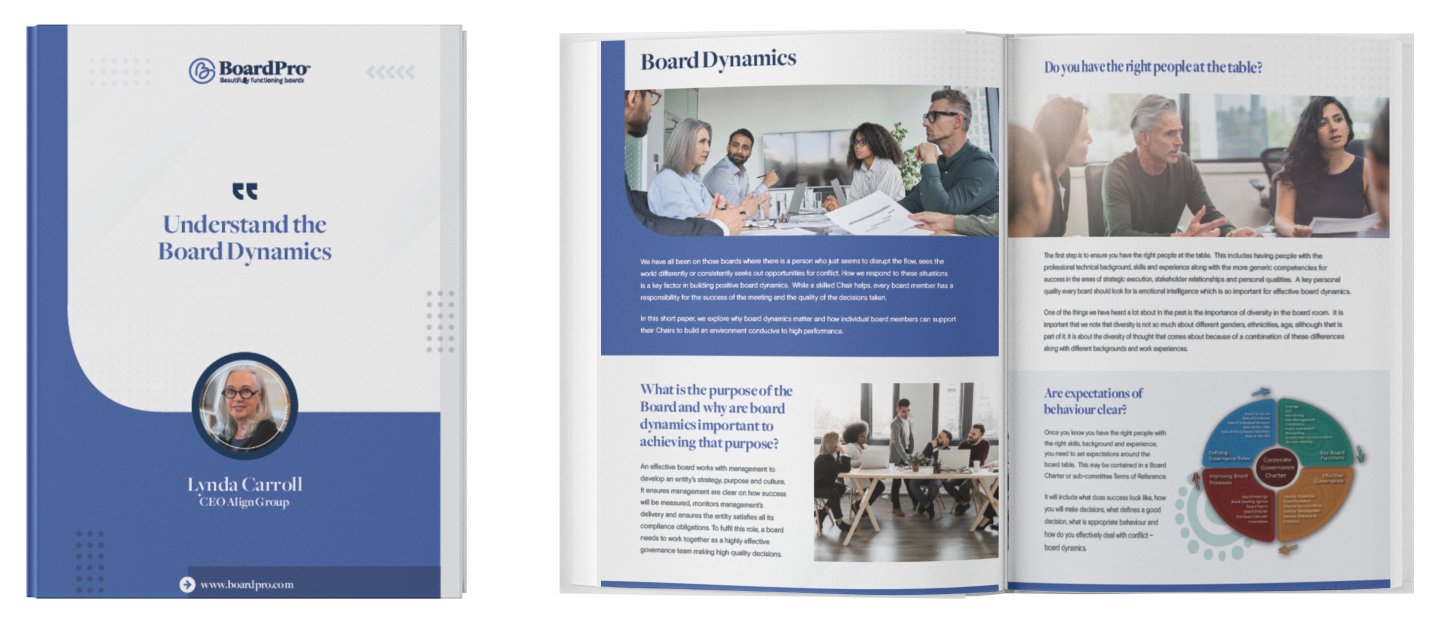We have all been on those boards where there is a person who just seems to disrupt the flow, sees the world differently or consistently seeks out opportunities for conflict. How we respond to these situations is a key factor in building positive board dynamics. While a skilled Chair helps, every board member has a responsibility for the success of the meeting and the quality of the decisions taken.
What is the purpose of the Board and why are board dynamics important to achieving that purpose?
An effective board works with management to develop an entity’s strategy, purpose and culture. It ensures management are clear on how success will be measured, monitors management’s delivery and ensures the entity satisfies all its compliance obligations. To fulfil this role, a board needs to work together as a highly effective governance team making high quality decisions.
Do you have the right people at the table?
The first step is to ensure you have the right people at the table. This includes having people with the professional technical background, skills and experience along with the more generic competencies for success in the areas of strategic execution, stakeholder relationships and personal qualities. A key personal quality every board should look for is emotional intelligence which is so important for effective board dynamics.
One of the things we have heard a lot about in the past is the importance of diversity in the boardroom. It is important that we note that diversity is not so much about different genders, ethnicities, age, although that is part of it, it is about the diversity of thought that comes about because of a combination of these differences along with different backgrounds and work experiences.
Are expectations of behaviour clear?
Once you know you have the right people with the right skills, background and experience, you need to set expectations around the board table. This may be contained in a Board Charter or sub-committee Terms of Reference.
It will include what does success look like, how you will make decisions, what defines a good decision, what is appropriate behaviour and how do you effectively deal with conflict – board dynamics.
How do you make high quality decisions?
Pete Senge talks about the difference between discussion and dialogue, and puts forward the view that you make high quality decisions through having strong dialogue where all points of view can be explored. This approach will often bring with it robust discussion and constructive challenge, as people with different ideas come together to explore the best approach to complex issues or opportunities.
How do you build strong relationships that will withstand possible conflict?
As board members, we come together once every six to eight weeks for perhaps a day or half a day. Our time together is usually focused on a detailed agenda and board papers requiring our decisions. We need to explicitly take the time to mindfully build strong relationships based on trust.
Charles Green has a great model to demonstrate the four ingredients that affect trust.

The ingredients contained in this equation are as follows:
- Credibility - this is about your knowledge base and experience. You are taking the seat at the table because of the value you can add.
- Reliability - this is all about your actions. Do you read the papers and contribute at board meetings?
- Intimacy – this is to do with how secure you feel in entrusting your personal information with your fellow board members. The more we know about someone, the more trustworthy we think them to be. It is about vulnerability.
-
These ingredients are all divided by one’s level of self orientation – this refers to our focus and how much we align to the interests of others. Do you act in the best interests of your fellow board members and the entity you govern as opposed to fulfilling your personal goals or ambitions?
How does board diversity impact relationships?
As boards become more diverse, there are greater opportunities for conflict – both good and bad. As a board we need to mindfully put in place opportunities for individual board members to build trustworthy relationships. This may be as part of the induction process of new board members; through informal chats while on health and safety site visits; at board dinners or during morning and afternoon tea. The important point is to recognise that these opportunities do not just appear, they need to be explicitly arranged.
What is your role vs the role of the Chair?
As with any role, you may have an effective or a not so effective Chair. When you have a good Chair, they will facilitate the meetings in such a way as to get the best out of the people at the Board table. They will manage the dominant participators, encourage the silent ones to come forward, and effectively deal with any inappropriate behaviour.
However, we all know that there are some Chairs who may be not so effective. When this is the case, you may need to step in and support good board dynamics. This might be as simple as having inviting someone to participate at the meeting; having a quiet word at lunch expressing how you value someone’s ideas; or it might be arranging to have a coffee catch up to talk through the (I am sure unintended) impact of inappropriate comments made – in a collegial manner of course.
At the end of the day, each and every one of us is responsible for the good board dynamics at our board table.
In this short paper, we explore why board dynamics matter and how individual board members can support their Chairs to build an environment conducive to high performance.

If you're looking for a tool to streamline your Board processes, check out BoardPro - an all-in-one software solution designed specifically for Boards and busy CEOs!
Schedule a demo with our team today and begin to experience a whole new way of meeting.
Share this
You May Also Like
These Related Stories

What does good conflict and lousy conflict look like in the boardroom?

How to remove the friction from your board meetings



